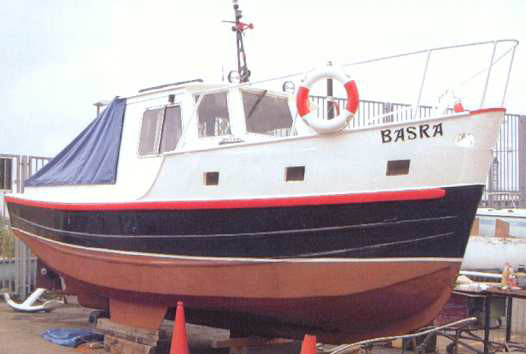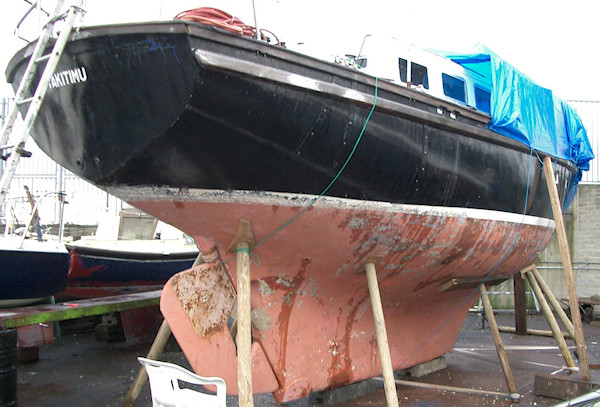C-Guard Liquid Copper Marine Antifoul: Application Guide
 Unlike conventional ‘one season’ antifouls, C-Guard Liquid Copper was developed to deter unwanted marine life for many years, ending the need for annual recoating.
Unlike conventional ‘one season’ antifouls, C-Guard Liquid Copper was developed to deter unwanted marine life for many years, ending the need for annual recoating.
Independent marine studies and early users confirm that the correctly applied treatment will resist weed and barnacle growth for some ten years. Classified as non-leaching, this copper rich epoxy demonstrates high levels of performance while simultaneously being more environmentally friendly than its short-term self eroding competitors. The complete treatment more than satisfies Health and Safety requirements. It is an epoxy resin emulsion, densely filled with copper and is very easy to apply.
- Good application gives protection from seaweed and barnacles.
- Fast cruising (over 15 knots) will keep the hull clean.
- The emulsion may be applied in high humidity and to damp (but not running wet) surfaces.
- Spray guns, rollers or paintbrushes may be cleaned with fresh water.
Use our guide to calculate how much C-Guard Liquid Copper you need
SURFACE PREPARATION
C-Guard Liquid Copper may be applied to the abraded gel-coat of new GRP hulls with no requirement to apply either primer or undercoat, but other materials will require suitable preparation. A regime of priming and undercoating prior to installing C-Guard Liquid Copper is required. For the following surfaces the necessary steps are:
GRP in Commission
De-grease the hull and abrade to remove badly adhering paint and antifouling. Hose down with clean water to remove dust. Well applied high quality epoxy coatings will only require abrading to cut the gloss and provide a key and hosing down. Apply two coats of C-Guard Liquid Copper.
Timber
Unless coated with an epoxy system, abrade down to bare wood. Apply one coat of C-Guard Epoxy Primer and two coats of C-Guard Liquid Copper.
Iron and Steel
It is best to blast clean to bare metal, hose down with fresh water and allow to dry before applying a coat of C-Guard Zinc Rich Primer, another of C-Guard Epoxy Primer and two of C-Guard Liquid Copper.
Aluminium
Degrease the hull with detergent and hose down with clean water and allow to dry. Apply one coat of Etch Primer. Allow to dry before applying a coat of C-Guard Epoxy Primer. Finish with two coats of C-Guard Liquid Copper.
Ferro-cement
Abrade to remove any poorly adhering coatings, hose down with clean water and allow to dry. Apply one coat of C-Guard Epoxy Primer and follow with two coats of C-Guard Liquid Copper.
MIXING LIQUID COPPER
All resin and hardener should be mixed thoroughly together before adding the copper powder. Then mix until all powder is blended completely with the epoxy resin. The mix has a pot life of about an hour at 15°C- 20°C.
THINNING
Do not thin C-Guard Liquid Copper when applying by brush. When using a roller C-Guard Liquid Copper may have the first coat thinned by up to 5% with de-ionised or distilled water, and up to 7% when spraying.
APPLICATION
Apply by brush, short pile or sponge roller or pressure pot spray system operating at 100-120psi.
Two coats are necessary on all surfaces in order to achieve full, non-slumping coverage. The weight of copper may drag if too generously applied. It is not uncommon to see the surface through the first coat.
Allow the first coat to gel (become tack free) for 3-6 hours at 20°C before applying the second coat. The period may be extended up to 24 hours between coats. Any time significantly beyond this will require abrasion of the coating before proceeding.
Allow the coating to cure for 2-3 days before abrading lightly with the scourer provided, or fine glass paper. This will expose a larger surface area of metallic copper for greater effectiveness.
The guidance above is available as a downloadable PDF:
C-Guard Liquid Copper Marine Antifoul application guide.
This is also available in Dutch, German, Spanish and French. Please contact us if you need any of these.

